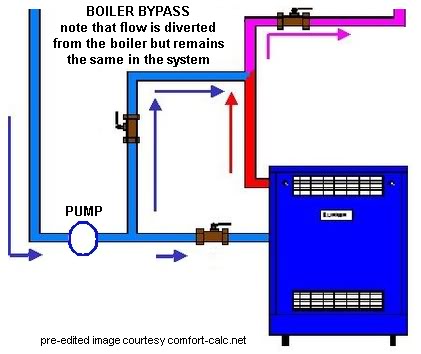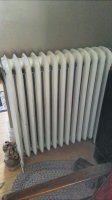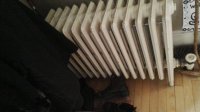Ryanarin
New Member
20 years ago when I bought my house (built in 1919) it had a huge, ancient hot water boiler covered with asbestos, that had been converted from coal to natural gas. I now wish I still had the thing (minus the asbestos).
In 2005, silly me thought it might be a good idea to replace it, even though it was completely reliable. I got a new "efficient" (!) condensing Munchkin boiler- bad idea. That gave me nothing but trouble, failing randomly because the sparker didn't work, among other things--it was the worst thing I have ever bought. Well, maybe.
In 2010, after I was told the Munchkin's heat exchanger was clogged with minerals/rust, and after the PRV had failed and flooded the basement, I had a different plumber take the thing out, and install a Weil-McClain cast iron boiler-- believing it would be able to handle my old radiators better.
Within 2 years of the new installation, the boiler system pressure was dropping daily-- the plumber who installed looked at it and when he heard the slow drip coming from under the boiler he groaned...it had a cracked section. He took the boiler apart and tried to get the cracked section replaced by W-M. They said it had clogged with mineral scale, (in two years since installing!) and that voided the warranty. So, he put in a replacement cast iron section, put the boiler back together, and I paind the cost for this repair ($1600).
It worked well for 2 years, so I thought it was money well spent. Nope!
The same issues (dropping pressure, dripping sound under the boiler but no visible water) reappeared last winter. I have been adding water to the system since then, and looking for signs of a leak somewhere else... two other plumbers have checked out the crawl space and the radiators to look for leaks there, and not found a thing. Under the boiler is dry--so the only sign of the leak is the sound of a drip. Also there is a squeal/hiss inside the boiler sometimes when its heating.
The plumber who installed the W-M has left the company, but his helper has taken over and says he can take it apart and replace a cracked section again, if that is the culprit. He also said he could add Fernox Leak Sealer for the time being, to see if that helps. I am leary of that stuff. On another online forum someone says that adding anything petroleum based to a W-M boiler will destroy the gaskets or o-rings.
So, should I just replace the boiler again, instead? The Weil-McClain is very reliable in other ways compared to the earlier munchkin, no problems aside from having to add water to bring up the pressure. I add about 4 psi every 2-3 days, to bring it up to about 14 psi. It seems to lose the most water when its cold, I have noticed.
When I read some of the problems people have with boilers, I wonder if I would again just be buying a whole new, different set of issues, if I replace it. I don't care at all about efficiency, considering I have spent an extremely inefficient 12k for two different boilers that don't work well, compared to the ancient original one.
If I should just replace, are there any recommendations for a simple and reliable, if not very efficient, boiler for an old house with lots of rust/mineral sediment in the pipes?
In 2005, silly me thought it might be a good idea to replace it, even though it was completely reliable. I got a new "efficient" (!) condensing Munchkin boiler- bad idea. That gave me nothing but trouble, failing randomly because the sparker didn't work, among other things--it was the worst thing I have ever bought. Well, maybe.
In 2010, after I was told the Munchkin's heat exchanger was clogged with minerals/rust, and after the PRV had failed and flooded the basement, I had a different plumber take the thing out, and install a Weil-McClain cast iron boiler-- believing it would be able to handle my old radiators better.
Within 2 years of the new installation, the boiler system pressure was dropping daily-- the plumber who installed looked at it and when he heard the slow drip coming from under the boiler he groaned...it had a cracked section. He took the boiler apart and tried to get the cracked section replaced by W-M. They said it had clogged with mineral scale, (in two years since installing!) and that voided the warranty. So, he put in a replacement cast iron section, put the boiler back together, and I paind the cost for this repair ($1600).
It worked well for 2 years, so I thought it was money well spent. Nope!
The same issues (dropping pressure, dripping sound under the boiler but no visible water) reappeared last winter. I have been adding water to the system since then, and looking for signs of a leak somewhere else... two other plumbers have checked out the crawl space and the radiators to look for leaks there, and not found a thing. Under the boiler is dry--so the only sign of the leak is the sound of a drip. Also there is a squeal/hiss inside the boiler sometimes when its heating.
The plumber who installed the W-M has left the company, but his helper has taken over and says he can take it apart and replace a cracked section again, if that is the culprit. He also said he could add Fernox Leak Sealer for the time being, to see if that helps. I am leary of that stuff. On another online forum someone says that adding anything petroleum based to a W-M boiler will destroy the gaskets or o-rings.
So, should I just replace the boiler again, instead? The Weil-McClain is very reliable in other ways compared to the earlier munchkin, no problems aside from having to add water to bring up the pressure. I add about 4 psi every 2-3 days, to bring it up to about 14 psi. It seems to lose the most water when its cold, I have noticed.
When I read some of the problems people have with boilers, I wonder if I would again just be buying a whole new, different set of issues, if I replace it. I don't care at all about efficiency, considering I have spent an extremely inefficient 12k for two different boilers that don't work well, compared to the ancient original one.
If I should just replace, are there any recommendations for a simple and reliable, if not very efficient, boiler for an old house with lots of rust/mineral sediment in the pipes?



